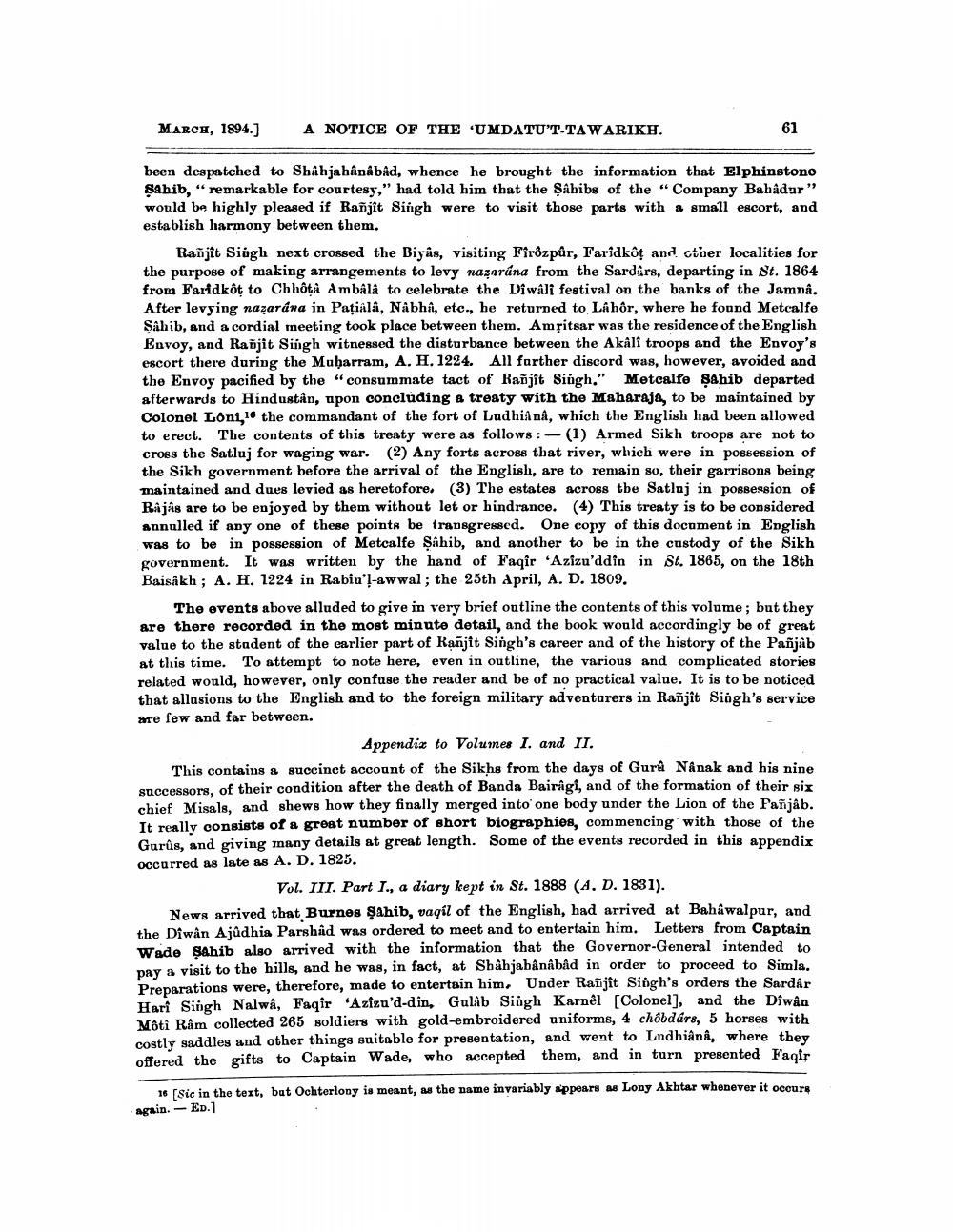________________
MARCH, 1894.)
A NOTICE OF THE 'UMDATU'T-TAWARIKH.
61
been despatched to Shahjahanábad, whence he brought the information that Elphinstone Sahib, "remarkable for courtesy," had told him that the şabibs of the “Company Bahadar" would be highly pleased if Ranjit Singh were to visit those parts with a small escort, and establish harmony between them.
Rañjit Siógh next crossed the Biyâs, visiting Firôzpůr, Faridkoţ and other localities for the purpose of making arrangements to levy nazarána from the Sardars, departing in St. 1864 from Faridkot to Chhôtà Ambâlâ to celebrate the Diwali festival on the banks of the Jamna. After levying nazarana in Patiala, Nabhi, etc., he returned to Lähôr, where he found Metcalfe Şahib, and a cordial meeting took place between them. Amritsar was the residence of the English Envoy, and Raõjit Singh witnessed the disturbance between the Akali troops and the Envoy's escort there during the Muharram, A. H. 1224. All farther discord was, however, avoided and the Envoy pacified by the "consummate tact of Ranjit Singh." Metcalfe sahib departed afterwards to Hindustan, upon concluding a treaty with the Maharaja, to be maintained by Colonel Lont,16 the commandant of the fort of Ludhiana, which the English had been allowed to erect. The contents of this treaty were as follows:-(1) Armed Sikh troops are not to cross the Satluj for waging war. (2) Any forts across that river, which were in possession of the Sikh government before the arrival of the English, are to remain so, their garrisons being maintained and dues levied as heretofore. (3) The estates across tbe Satluj in possession of Rajâs are to be enjoyed by them without let or hindrance. (4) This treaty is to be considered annulled if any one of these points be transgressed. One copy of this document in English was to be in possession of Metcalfe Şahib, and another to be in the custody of the Sikh government. It was written by the hand of Faqir 'Azizu'ddîn in st. 1865, on the 18th Baisakh ; A. H. 1224 in Rabîu'l-awwal; the 25th April, A. D. 1809.
The events above alluded to give in very brief outline the contents of this volume; but they are there recorded in the most minute detail, and the book would accordingly be of great value to the stadent of the earlier part of Ranjit Singh's career and of the history of the Pañjab at this time. To attempt to note here, even in outline, the various and complicated stories related would, however, only confuse the reader and be of no practical value. It is to be noticed that allasions to the English and to the foreign military adventurers in Rañjit Singh's service are few and far between.
Appendix to Volumes I. and II. This contains a succinct account of the Sikhs from the days of Gurê Nának and his nine successors, of their condition after the death of Banda Bairagi, and of the formation of their six chief Misals, and shews how they finally merged into one body under the Lion of the Pañjáb. It really consists of a great number of short biographies, commencing with those of the Gurûs, and giving many details at great length. Some of the events recorded in this appendix occurred as late as A. D. 1825.
Vol. III. Part I., a diary kept in St. 1888 (A. D. 1831). News arrived that Burnes şahib, vaqil of the English, had arrived at Bahawalpur, and the Diwan Ajudhia Parshid was ordered to meet and to entertain him. Letters from Captain Wade Sahib also arrived with the information that the Governor-General intended to pay a visit to the hills, and he was, in fact, at Shahjahânâbâd in order to proceed to Simla. Preparations were, therefore, made to entertain him, Under Ranjit Singh's orders the Sardár Hari Singh Nalwâ, Faqir 'Azizu'd-din, Gulab Singh Karnel (Colonel], and the Diwan Môti Râm collected 265 soldiers with gold-embroidered uniforms, 4 chodárs, 5 horses with costly saddles and other things suitable for presentation, and went to Ludhiana, where they offered the gifts to Captain Wade, who accepted them, and in turn presented Fagir
16 [Sic in the text, bat Ochterlony is meant, as the name invariably sippears as Lony Akhtar whenever it occurs again. -Ed.1




